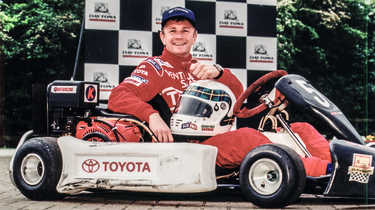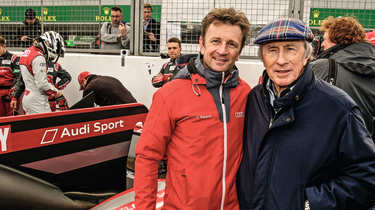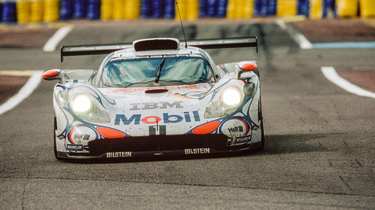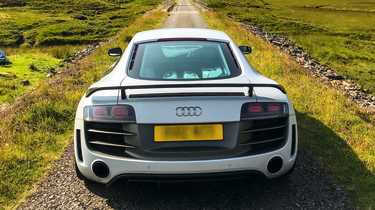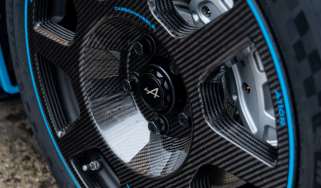My Life & Cars – Allan McNish, three-time Le Mans winner
A decade on from his retirement from racing, Allan McNish talks about his journey from karting to a trio of Le Mans victories – and more
Do you recall the Porsche 911 GT1 in evo issue 001? Allan McNish does, though not for the reasons you might expect. ‘I remember it well,’ he says as we email back and forth to arrange our chat. ‘An old BT van tried to have a race with us on the dual carriageway…’
Given McNish had just stepped down from the top step of the podium at Le Mans, and the 544bhp GT1 was one of the world’s most potent road cars at the time, it’s fair to assume the BT van didn’t stand a chance. Still, it’s in good company: McNish subsequently added a further two Le Mans victories, five wins at Sebring, three ALMS titles and a WEC crown to his tally, so it isn’t just BT vans he’s trounced over the years. Were Formula 1 not so impenetrable to so many talented drivers, we could just as easily be talking F1 titles. Or, as it turns out, motorcycling.
> My Life & Cars – Tim Layzell, motorsport artist and amateur racer
‘I grew up in Dumfries, and there it’s traditionally been a rallying area, because it’s all forests and farms. But the other thing is motorbikes, so motocross, but also the Isle of Man, which you can see on a clear day.
‘So I had a little motocross bike, but I was too small. I needed to go up from 50cc to 80cc due to the regulations, but the 80cc had gone from a twin-shock rear to a single shock, which raised the seat height. Which was fine if you were… not small, but my feet didn’t even touch the pegs, never mind the ground, so that put a dampener on things.’
Inspiration came in other forms though, and as McNish was buzzing around on bikes, a certain David Leslie was making a name for himself in Formula 3. Allan’s father knew David’s father and helped out at races on occasion. ‘The spark really came from there,’ says McNish. That connection led to him trying out a kart for the first time, ‘and from that moment it just evolved. It was a hobby, but one I was quite good at, and it gave me direction, something I wanted to do more than anything else.’
Not that McNish ever saw it as a potential career at that stage. ‘I started late. I was 11, nearly 12 before I started karting, and you had to be 14 for international events, so I was just doing tracks in England and Scotland, and only about three of those were easy to get to. I did four and a bit years of karting, the last year of juniors was international and in one year of seniors I did both national and international, and then I went into Formula Ford.’
Again it was David Leslie and his father who helped out here. ‘They literally ran the car. They were the mechanics, engineering, bacon roll maker, the whole shebang.’ Surprisingly though, despite taking race wins in single-seaters, McNish didn’t actually warm to Formula Fords immediately. ‘At the end of the year I’d have quite happily gone back to karts; it was a bit more me. One thing I struggled with in Formula Ford was that it didn’t matter what you did, the car was sliding around everywhere, it was like ice skating.’
It was a test through the Marlboro Young Driver Academy at Donington Park that changed things. Suddenly, behind the wheel of a Formula Ford 2000, McNish had all the grip he was missing with the regular Fords. ‘It had a bit of aero, it had slick tyres, it wasn’t sliding out of control all the time, and I felt like I had something there.’
McNish continued his path through the ranks, winning the UK Formula Vauxhall Lotus title, taking a third place in the European series, and then jumping into Formula 3. But it was only at the first F1 test that McNish realised he could make a career from racing.
‘It was at Estoril, with McLaren, and Senna in the sister car. He was talking about things I didn’t even think about, or couldn’t feel, and I realised that if I wanted to be serious [about racing], I really had to knuckle down. It wasn’t a hobby; you had to put in the effort and have the work ethic.’
It was a learning experience, and not just on the racetrack. ‘I had to pass my driving test to get my racing licence to go to my first race,’ he says. ‘It was two things for me though. Firstly a requirement, but also just the ability to move. Prior to that, when I was karting, I was taking trains everywhere. From Dumfries, everything was a trek – Oulton Park, which is fairly easy to get to for most people, was three hours south.’
His early road cars were very much tools. The family owned a dealership, and most of McNish’s on-road experiences were either getting to and from tracks in cars they had in stock, or delivering them – sometimes a mix of both. ‘The ones that stuck in my memory were due to how well they drove over the roads from Dumfries to Moffat, and then across the country to Edinburgh airport. There was a wee Alfasud which had a brilliant gearbox. Small and agile, a wheel in each corner… and I remember a Porsche 944 too. That was lovely. Just floated its way over that road.’
It was road cars that allowed McNish to develop certain driving techniques away from the track, too. ‘I didn’t know how to heel and toe, which you had to do in those days. Driving the Vauxhall Lotus you could just smack the brake and bang down the gearbox when it felt right, but when I did my first Formula 1 test I had to synchronise everything, because the revs were higher and the gaps between gears were bigger. So that winter I drove everywhere heeling and toeing on the road, with a synchromesh gearbox.’
McNish sees himself as fortunate that he had the backing of Marlboro and other sponsors early on, helping him to rise through the ranks, but as with so many drivers his F1 tests never quite turned into a drive at the top level. Instead, it was a meeting with Jost Capito and an invitation to a Porsche Supercup race that laid a different path towards sportscars.
While McNish couldn’t drive immediately, an opportunity arose to compete at Silverstone alongside the British Grand Prix. ‘It’s got to be one of the hardest things I’ve ever driven in my life! My teammate was [Grand Prix motorcycle champion] Kevin Schwantz, and we’d both tested the car at Weissach, which was tight and twisty, and then you get to Silverstone, which is fast and flowing, and the engine’s hanging out like a trailer at the back…’
The Porsche connection led to an invitation to join a GT1 test. ‘I’d always had this preconception that sportscar racing was all about conserving the car, and it was driving at 70 per cent – not really for me. But through David Leslie’s involvement with Ray Mallock, and racing against Derek Bell’s son, Justin, I had more understanding. And then I turned up at Paul Ricard, and had another test at Michelin’s test track, and realised this is actually really good! It’s got a lot of power, it’s got grip, and it just all fitted. They asked if I wanted to race, fill in at certain events. It was a bit ad hoc. At the final race we got into the lead – the first time they’d led a race that season – and they signed me up for the future.’
So what was it like driving at Le Mans for the first time? ‘Terrifying. It wasn’t like I was inexperienced, but the first time I accelerated down the Mulsanne it was like the car was about to take off. There are tram lines in the road, and the car is horizontally moving, vertically moving, and it felt like I was doing a thousand miles per hour. I then braked so early for the first chicane I had to accelerate and change up again. Anyone driving around me must have thought I’d taken a wrong turn off the motorway…’
McNish reckons he truly had a handle on the GT1 by the end of the winning 1998 event where he partnered Laurent Aïello and Stéphane Ortelli. But then Porsche pulled the plug on GT racing. ‘I had meetings with BMW, Toyota and Mercedes, who were the three main manufacturers. I went with Toyota for a couple of reasons. It was Ove Andersson and André de Cortanze running the ship, and they laid out exactly what they wanted – they had a vision, and I was a clear part of it.
Toyota’s 1999 Le Mans effort didn’t yield a win, and McNish’s car was taken out mid-race by a tyre failure while Thierry Boutsen was at the wheel. But it did lead to the Scot’s brief stint in Formula 1. ‘By 2001 the cars were very different from the ones I’d last tested in ’94 or ’95. To be frank, it was too late in my career, but I’d fought like hell to have that opportunity, and I thought, what’s the downside? If it didn’t work out, I’ll go back to sportscars. But it actually developed me massively as a driver. By the time I went back to sportscars I was a more rounded driver, and probably more ruthless – as well as having a better understanding of the politics of big business, which is still helping me today.’
McNish had begun his relationship with Audi in 2000, and slotted straight back into the team when returning from F1. ‘When I came back and drove a sportscar for the first time, it was like I’d never been away,’ he says. Audi’s car at the time, the R8 Le Mans Prototype, had developed for the better in the meantime. ‘At first it was a bit of a brute; you really had to manhandle it. But by the time I came back, Audi had developed direct injection and they’d worked out some tweaks to stabilise the car. Then, when the R10 arrived, it was like a bucking bronco again! It made significantly more torque than an F1 car, and the weight distribution wasn’t ideal because of the V12 – but it was actually less terrifying in the wet than in the dry, because it was so tractable.’
We’ve all heard the adage that Le Mans is more of a ‘24-hour sprint’ today than it used to be, something McNish puts down not just to improvements in reliability, but also ease of maintenance. ‘The weak link used to be the gearbox. When Audi introduced a quick-change gearbox it was still a weak link, but it didn’t matter, because you could change it in four and a half minutes. You still need to conserve the car, but when the concept became driving the car as fast as possible, that fit with my driving style – to get stuck in and go for it.’
Racing has left little time for road cars, but McNish still has a fondness for certain machines. He was a fan of the Audi RS5 when it first emerged, with its ‘beautiful, sculpted look’, and there’s an R8 GT in the stable, alongside a Suzuki GSX‑R 750, bought with the prize money from winning Le Mans in 1998 – though that currently resides in Scotland, some distance from his Monaco home.
One final question: having retired at the end of 2013, does McNish miss racing? ‘No,’ he says. ‘I’ve done my bit, done what I wanted to do. When I made the decision, I sat down with Jackie Stewart and told him, and he said, “Good. It’s the right decision, the right time.” It’s all about looking forward, never back, and knowing when to get in, and when to get out.'
This story was first featured in evo issue 317.


